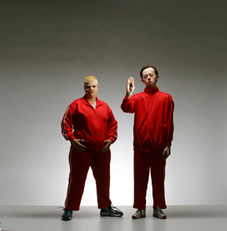 |
Sonia Teuben, Simon Laherty, Small Metal Objects photo Jeff Busby |
This public space is converted into a stage, and the public are the performers. A conversation between two men is heard through the earphones, punctuated by electronic music, while the audience looks out at an almost empty square searching for the source of the voices. I spot the pair as they pass the bakery; the square is so empty that it’s not hard. They wander towards us, while people walk past and stare at both the performers and us.
The characters, Gary and Steve, both appear to have a disability, made obvious to the public by their physical appearance; and so the stares they receive have a different focus to ours. We have voluntarily placed ourselves in this position, and we can slip out of it after the show when we remove the headphones. I must admit, this is of particular interest to me, because I have worked in the disability services field, and have regularly witnessed quite negative reactions from the public towards people with physical and developmental disabilities. This theme makes Small Metal Objects personally compelling, even more than the dialogue unfolding.
It begins with a conversation about marriage, sexual orientation and the death of Steve’s cat. The language is slow and simple, caring, patient and understanding. Then Gary takes a phone call from a nervous sounding man, Alan, who enters the square, carrying an envelope of cash and talk of a ‘deal’. A ‘business partner’ of Alan’s, a corporate psychologist, is called to the scene when Steve refuses to cooperate in the deal, and she takes over from Alan using different methods of persuasion. Steve needs time, Gary explains to the anxious, pacing Alan, while the music becomes deeper, percussive and suspenseful, matching the tension felt by Alan and his partner. What follows is a sickening display of misunderstanding and disrespect.
However, there is an element of humour in the production, a welcome addition to a grave subject. The introduction of the ‘corporate psychologist’ for instance, where a jargon filled job description designed to impress the listener, fails on the uninterested Gary who obviously holds different values. Later, Steve turns to Gary and says of Alan: “I know he’s famous and all but he just looks like an ordinary guy”.
I did wonder what the production would be like if the square was filled with people. Due to the cold weather and time of the day, the space was almost completely empty, whereas the production is designed for a crowded public space. The actors utilised the space well, traversing the entire square; and I can imagine that my response would be very different if the figures were blending with the public and often blocked from view. In saying that however, the empty square did work as a positive in some instances, such as when Alan was first looking for Gary. Despite standing near him, Alan walked away approaching the few other people in the area, before finally returning to Gary, an emphatic last resort.
The values manifest in Gary and Steve’s characters and their relationship are beautifully observed and played out in the production, in distinct opposition to Alan and his partner. These are accentuated by the body language, contributing in particular to the key interactions between the characters. I have never seen such an original and entertaining attempt to challenge social attitudes that discriminate against people with disabilities.
Back to Back Theatre, Small Metal Objects, director Bruce Gladwin, co-devisers Bruce Gladwin, Simon Laherty, Sonia Teuben, Genevieve Morris and Jim Russell, sound composition/design Hugh Covill, Salamanca Square, Ten Days on the Island, March 28-31
Lucy Hawthorne is a Hobart based writer with a background in visual arts (sculpture, drawing, sound and installation art), music and dog obsession. She is a postgraduate studying art and design theory at the Tasmanian School of Art.
© Lucy Hawthorne; for permission to reproduce apply to [email protected]








 back
back